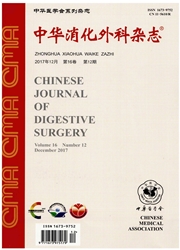

 中文摘要:
中文摘要:
目的:探讨影响胃肠道间质瘤(GISTs)术后复发危险因素;验证美国纪念斯隆凯特琳癌症中心(MSKCC)列线图的临床实用价值;建立新的列线图模型及校对曲线。 方法: 采用回顾性病例对照研究方法。收集2000年6月至2009年1月山西医科大学附属肿瘤医院收治的90例GISTs患者的临床资料。所有患者行根治性切除术,术后未服用靶向药物甲磺酸伊马替尼辅助治疗。收集数据库中患者的临床病理资料进行预后分析。采用MSKCC列线图预测GISTs患者术后情况,通过Bootstrop自抽样得到新样本几率与患者复发的真实几率比较,计算其ROC曲线下面积;经COX模型多因素分析后,运用R语言建立新的列线图模型及校准曲线。观察指标:(1)GISTs患者术后复发情况。(2)影响GISTs患者术后复发的危险因素分析。(3)MSKCC列线图预测每例GISTs患者术后理论复发情况。(4)建立新的列线图模型及校准曲线。 采用电话、门诊、家访方式进行随访。了解GISTs患者术后复发情况,随访时间截至2016年2月。采用KaplanMeier法绘制生存曲线,单因素分析采用χ2检验,多因素分析采用COX比例风险模型,建立GISTs患者术后复发风险模型。列线图根据COX模型中入选变量的回归系数等信息绘制患者术后无复发生存率的列线图模型及校准曲线。 结果:(1)GISTs术后复发情况:90例GISTs患者随访1~82个月,中位随访时间为25个月。2年无复发生存率为52.2%(47/90),5年无复发生存率为11.1%(10/90)。(2)影响GISTs患者术后复发的危险因素:单因素分析结果显示:年龄、CD117、肿瘤部位、肿瘤直径、核分裂象是影响GISTs患者术后5年复发的危险因素(χ2=9.276,19.911,31.721,32.973,6.482,P〈0.05)。多因素分析结果显示:肿瘤部位为其他、肿瘤直径≥10 cm、核分裂象≥5/50高倍视野是影响GISTs患者术后5
 英文摘要:
英文摘要:
Objective:To investigate the risk factors of postoperative recurrence of gastrointestinal stromal tumors (GISTs) and verify the clinical value of nomogram of the Memorial Sloan Kettering Cancer Center (MSKCC), and draw a new nomogram model and a calibration curve. Methods:The retrospective casecontrol study was conducted. The clinical data of 90 patients with GISTs who were admitted to the Affiliated Cancer Hospital of Shanxi Medical University between June 2000 and January 2009 were collected. 〖HJ〗All the patients underwent radical resection of GISTs and didn′t take oral imatinib mesylate of postoperative adjunctive therapy. The clinicopathological data of patients were used for prognostic analysis. Postoperative GISTs of patients were predicted by nomogram of the MSKCC. Area under ROC curves was calculated through the comparison between probability of new samples from Bootstrop and real probability of recurrence of patients. A new nomogram model and calibration curve were built using the R language. Observation indicators: (1) real recurrence situations of GISTs; (2) risk factors analysis affecting the postoperative recurrence of GISTs; (3) a nomogram of MSKCC predicting the postoperative theoretical recurrence situations of GISTs in each patient; (4) establishment of the new nomogram model and calibration curve. The followup using telephone interview, outpatient examination and visit was performed to detect the postoperative recurrence of GISTs up to February 2016. The survival curve was drawn by the KaplanMeier method. The univariate analysis and multivariate analysis were done respectively using the chisqaure test and COX regression model. A risk model of postoperative recurrence of GISTs was built. The new nomogram model and calibration curve of postoperative recurrencefree survival rate were drawn according to the regression coefficients and other data of selected variables in the COX regression model. Results:(1) Real recurrence situations of GISTs: all the
 同期刊论文项目
同期刊论文项目
 同项目期刊论文
同项目期刊论文
 期刊信息
期刊信息
